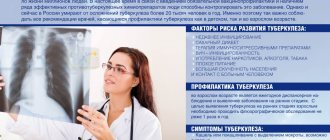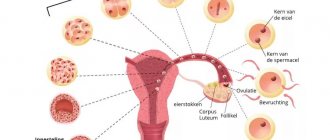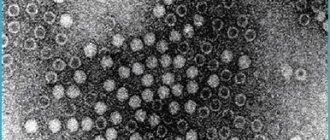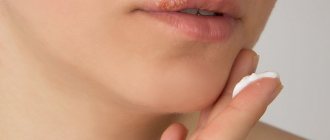Author:
Butriy Sergey Alexandrovich pediatrician
Quick transition Treatment of atopic dermatitis in children
Atopic dermatitis is a disease in which the skin becomes very itchy, irritated, red, dry, and uneven.
Atopic dermatitis is a common skin disease that is part of a group of skin diseases combined under the broader term “eczema.”
There are other types of eczema: nummular, dyshidrotic, etc. However, the terms “eczema” and “atopic dermatitis” are often used interchangeably.
As a rule, atopic dermatitis debuts in infancy (3–6 months) and occurs in 15–20% of children. Most often, its course is most severe in the first 1–3 years of life; as the child grows older, the severity of the disease decreases. Atopic dermatitis usually disappears by school age or puberty. However, in some people the disease can persist throughout their lives, occasionally worsening, or appearing constantly.
What are the causes of the disease?
It is necessary to distinguish between the cause and triggers of atopic dermatitis.
The reason is not fully known to modern science; the main version is a set of genetic, immune and skin changes, in particular, a deficiency of the skin protein filaggrin, which is responsible for retaining moisture in the skin.
The triggers of atopic dermatitis are very diverse, atopic skin is overly sensitive to irritation, so exacerbation can be caused by increased sweating, heat, rough clothing, detergents, dry air, etc. Children with atopic dermatitis may simultaneously have allergies to food, household or other animals, dust mites, tree and grass pollen - these allergens can also be triggers for exacerbations.
In general, atopic dermatitis has a wave-like course, periods of exacerbations (most often occurring for unobvious reasons or for no reason) are replaced by periods of remission - hence there is a great temptation to associate exacerbations with factors that are not directly related to the disease, and vice versa - to attribute healing properties to completely extraneous factors (for example, a diet that parents started by mistake or out of desperation).
It is impossible not to mention the established harmful domestic tradition of calling atopic dermatitis allergic (usually associating it with an allergy to cow’s milk protein) and treating it with diets (a strict “hypoallergenic” diet for a nursing mother, and/or a hydrolysis/amino acid mixture for a child). Indeed, if a child has an intolerance to cow's milk proteins, it may aggravate or cause atopic dermatitis, but not vice versa. Not every child with atopic dermatitis has an intolerance to cow's milk proteins or any other allergens. This means that by prescribing a diet, or an expensive and unpleasant-tasting mixture, the doctor adds problems to the family without helping them. In most cases of atopic dermatitis, identifying allergies and excluding allergens does not provide any benefit.
Manifestations of atopic dermatitis
Skin symptoms and location of lesions vary in children of different ages. Common symptoms are the appearance of red, dry, itchy patches on the skin that occur as a result of inflammation. There is always itching - from mild to unbearable, disrupting sleep and appetite. Frequent scratching may cause scratches (scratching), oozing (separation of serous exudate through tiny defects in the epidermis), crusting, or erosion due to secondary infection. Sometimes, if atopic skin lesions, lesions from chronic pruritus and secondary infections last for many weeks, areas of skin atrophy (scars, hypopigmentation/hyperpigmentation, thinning or thickening of the skin) may develop.
In infants, atopic dermatitis usually affects the face, scalp, arms and legs. In older children, as a rule, only the elbows, popliteal fossae and wrists are affected. In some children with severe disease, the entire body may be affected. Eczema causes severe itching, which can in turn lead to a number of secondary problems: sleep disturbances, weight loss, depression (in the child or in the adult who cares for him), etc.
Symptoms usually worsen in the autumn-winter period (this fact is usually associated with the inclusion of central heating and more severe external climatic conditions) and improve in the spring-summer period, as well as in seaside resorts (this is usually associated with the abundance of ultraviolet radiation and milder climatic influences on affected skin). Typically, the most severe course of the disease is observed in children aged 6–18 months (in winter, exacerbations are more frequent and severe, in summer - less frequent and milder), then from year to year, exacerbations become less frequent and milder. By school, most children recover or have symptoms that do not reduce their quality of life.
Types of emollients
There are three main types of emollients.
- Natural.
They contain vegetable oils: peach, almond, shea butter, jojoba, cocoa, lanolin, wax. Their advantage is that they are of natural origin. The disadvantage is that they can cause an allergic reaction. More often, natural components are not tolerated by adult patients. Therefore, a natural-based cosmetic product is a good choice for a baby. - Chemical.
They use substances obtained during oil refining. These include: paraffin, silicone, mineral oils, petroleum jelly. Such emollients create a dense film and make it difficult for the skin to breathe. However, they rarely cause an allergic reaction. For children, this is the least preferred type of cosmetic product. - Synthetic.
Their basis is substances obtained as a result of chemical synthesis. For example, dimethicones and cyclomethicones. Such substances perform their barrier function well, interfere with skin breathing to a lesser extent and rarely cause an allergic reaction.
Additionally, emollients include moisturizing substances: urea, lactic acid, hyaluronic acid, glycerol, and the like. Some cosmetics also include fat-soluble vitamins: A, E, PP.
Ready-made cosmetics based on emollient are divided into types:
- Ointments
are products made from fats. They have the densest consistency and are applied to skin with severe dryness and flaking. Children rarely need this type of emollient. - Creams
are water-fat based products. They have a pleasant consistency, absorb well and moisturize the skin. Such products are the most common option for skin care in children and atopic dermatitis. - An emulsion
is a water-fat based product that has a thinner consistency than a cream. This product is convenient to apply to large surfaces of the body. They are usually sold in large bottles. - Lotion
is a water-based product. It is preferable to use it on skin prone to weeping (inflammation with the formation of blisters). This type of cosmetic product is not suitable for dry skin.
In the line of skin care products, there are special products that are added to the water when bathing: shampoos, shower gels, hand soap.
Diagnostics
There is no specific test or examination to confirm the diagnosis of atopic dermatitis; the diagnosis is made clinically. The doctor will examine the rash and ask about the child's symptoms and family history of atopy and allergies. A history of eczema in family members (either as a child or still today) will be an important clue.
Your doctor will rule out other conditions that may cause your skin to become inflamed or itchy. In case of difficulties with diagnosis or severe course of the disease, the pediatrician will refer the child to a pediatric dermatologist or pediatric allergist.
The doctor may ask you to eliminate certain foods (such as eggs, milk, soy, or nuts) from your child's diet for 2 to 3 weeks before reintroducing them and monitoring symptoms. If the diet leads to relief of the rash, and provocation leads to its obvious exacerbation, this will confirm the diagnosis and the need for a diet.
Since there are no accurate laboratory methods for confirming the diagnosis of atopic dermatitis, there are criteria for standardizing the clinical diagnosis (the best known are the Hanifin and Raika criteria).
The criteria are divided into “large” and “small”. To make a diagnosis of atopic dermatitis, it is necessary and sufficient to detect three major and three minor criteria in the patient.
The big ones include:
- itching;
- dermatitis affecting the flexor surfaces in adults, or the face and extensor surfaces in infants;
- chronic or recurrent dermatitis;
- a personal or family history of skin or respiratory allergies.
Small ones include:
- specific facial features: facial pallor, erythema, hypopigmented spots, dark circles under the eyes, cheilitis, infraorbital folds, recurrent conjunctivitis, anterior neck folds;
- typical triggers: emotional factors, environmental factors, food, skin irritants;
- typical complications: susceptibility to skin infections, impaired cellular immunity, predisposition to keratoconus and anterior subcapsular cataracts, immediate skin reactivity;
- other signs: early age of onset, dry skin, ichthyosis, hyperlinearity of the palms, piliary keratosis, dermatitis of the hands and feet, nipple eczema, white dermographism, white pityriasis, perifollicular accentuation.
An explanation of each of these symptoms is beyond the scope of this article; The criteria are given here to help you understand what the doctor is guided by when making a diagnosis of atopic dermatitis.
There are also various scales for assessing the severity of atopic dermatitis used by doctors and scientists, the most famous of which is the SCORAD scale. In this scale, the doctor must note the number, prevalence and severity of symptoms of atopic dermatitis, express them in points, sum up the points and, based on this sum, set the severity of the disease.
Treatment of atopic dermatitis in children
There is no complete treatment for atopic dermatitis, that is, there are no methods of therapy that would lead to complete recovery (change the long-term prognosis of the disease). All existing methods of therapy change only the short-term prognosis - for the coming months.
However, treatment is necessary:
- to improve the quality of life of the child and family; for the prevention of secondary local complications (infections, skin atrophy, etc.);
- for the prevention of psychological problems (sleep disorders, depression, etc.).
Treatment is divided into lifestyle changes (eliminating triggers) and drug interventions (eliminating symptoms).
Change of life. What can parents do themselves?
Don't let your baby's skin become excessively dry, severe itching, and avoid triggers. Try following these simple tips:
- Children with atopic dermatitis should take short baths or shower with warm (not hot) water. Use mild, unscented soap or soap-free cleansers. Do not wipe, but pat your skin with a towel after washing. Immediately after bathing, apply moisturizer to your entire skin. Teenagers prefer to use unscented cosmetics and oil-free facial moisturizers.
- Consult your doctor; if your child has no contraindications, add oat decoction to the bath when bathing; it can reduce itching.
- Preference should be given to soft children's clothing made from breathable fabrics, such as cotton. Wool or polyester may be too harsh or irritating for atopic skin.
- Your child's nails should be trimmed regularly and short to prevent scratching of the skin. If your child scratches himself at night, try putting him to bed in comfortable, lightweight mittens or with the sleeves of his pajamas sewn up.
- Overheating of children should be avoided, as sweat can lead to exacerbations. This is especially true for Russian parents who are accustomed to hot temperatures in the apartment and wrapping their children up during walks.
- Children should be encouraged to drink plenty of water.
- Try to get rid of common allergens in and outside your home, such as pollen, mold and tobacco smoke.
- Stress can make atopic dermatitis worse. Help your child find ways to cope with stress (such as exercise, deep breathing, or talking to a counselor).
Do emollients have any contraindications or disadvantages?
Emollients are not a medicine, but a care product. This means that there are no special indications for them. Such cosmetics can also be used for ordinary skin to maintain or improve its condition. However, there are still some restrictions on the use of such cosmetics:
- As with any other skin care product, emollients can cause a contact allergic reaction. Therefore, before generously applying the product to the entire surface of the skin, test it on a small area of the inner surface of the forearm. Apply a small amount of emollient and observe the reaction during the day;
- Do not apply emollient to skin with an acute inflammatory rash, weeping or fresh scratching. Creating a film will increase the risk of spreading infection. Such skin must first be treated with medications.
- emollient containing urea or ammonia should not be applied to areas with injured skin. When such products are applied to injured skin, a burning sensation occurs in these areas.
- Before you start using emollient, you should show your baby to a doctor. Your doctor may recommend using a care product and medicine at the same time. Either cure dermatitis first, and then select a cosmetic product;
There are some inconveniences when using emollients. For example, with abundant and frequent application, underwear and bed linen become dirty. Some mothers of my patients over one year old pay attention to the fact that children do not like the feeling of a thick layer of cosmetic product on the skin. However, most kids quickly get used to it.
Another inconvenience occurs when emollients added to the water during bathing, or applied before bathing, leave a residue on the surface of the bath. This plaque must be washed off with detergents.







